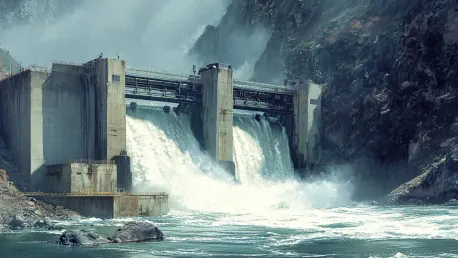Hydropower has long been a backbone of America’s renewable energy sector. As the nation advances toward a greener future and the demand for clean energy intensifies, the strategic importance of hydropower cannot be understated. This pivotal energy source boasts a rich history of over 140 years, characterized by its consistent contributions to energy security, economic stability, and environmental sustainability. The pressing need to recognize and bolster hydropower’s role in the contemporary energy landscape is paramount, especially amidst the growing challenges and regulatory hurdles. This article delves into the multifaceted benefits of hydropower, its indispensable role, the current obstacles the industry faces, and the steps required to secure its place in America’s clean energy future.
The Historical Significance of Hydropower
Since its inception over 140 years ago, hydropower has been an integral part of America’s renewable energy portfolio. Hydropower forms a cornerstone of America’s renewable energy sector, contributing immensely to the country’s overall electricity generation. The nation’s hydropower infrastructure comprises 2,252 plants scattered across 48 states, which collectively generate an impressive 80.58 gigawatts (GW) of electricity. This formidable output, augmented by an additional 22 GW from pumped storage, constitutes over 100 GW of reliable, carbon-free energy. Such a capacity is substantial enough to power approximately 30 million American homes and businesses, underscoring hydropower’s critical role in sustaining both energy needs and economic vitality.
The longevity and reliability of hydropower facilities further illustrate its sustained contributions. Many of these plants have been operational for decades, bearing testament to hydropower’s enduring presence in America’s energy landscape. Beyond mere electricity generation, these facilities have fostered economic development, contributed to environmental sustainability, and supported local communities. Hydropower’s historical significance lies not only in its ability to consistently provide a dependable energy source but also in its role in sustaining communities both economically and environmentally.
Multifaceted Benefits of Hydropower
Hydropower offers a myriad of benefits that extend far beyond the realm of electricity generation. One of its notable advantages lies in its inherent flexibility and reliability, making it a quintessential partner for other renewable energy sources like wind and solar power. Unlike these intermittent sources, which are heavily reliant on weather conditions, hydropower can be swiftly adjusted to match fluctuating energy demands. This capability ensures grid stability and acts as a complementary buffer, thereby enhancing the overall efficiency and reliability of the power grid.
Moreover, the hydropower industry plays a pivotal role in job creation and economic development. The sector employs thousands of workers across various fields, ranging from engineers and plant operators to environmental scientists and maintenance crews. This wide array of employment opportunities fosters job growth and contributes significantly to both local and national economies. Beyond direct employment, hydropower projects stimulate economic activity in related sectors and help sustain a vibrant workforce dedicated to advancing renewable energy goals.
The environmental benefits of hydropower are equally noteworthy. As a source of carbon-free electricity, hydropower contributes to reducing greenhouse gas emissions, thereby mitigating the effects of climate change. Additionally, hydropower facilities often incorporate fish ladders, wildlife corridors, and other ecological measures to preserve local habitats and biodiversity. By blending technological innovation with environmental stewardship, hydropower exemplifies a holistic approach to sustainable energy generation.
Challenges Facing the Industry
Despite its numerous benefits, the hydropower industry is not without its challenges, particularly when it comes to regulatory issues. One of the most pressing concerns is the imminent risk of decommissioning nearly 450 hydro facilities by 2035 due to expiring licenses. The relicensing process is notoriously lengthy and costly, often taking more than seven years to complete and involving millions of dollars in administrative expenses. Such burdensome requirements deter many asset owners, leading them to contemplate the decommissioning of facilities rather than enduring the regulatory complexities.
These regulatory hurdles pose a significant threat to the industry’s stability and growth. The potential decommissioning of critical hydropower facilities could result in the loss of approximately 16 GW of electrical capacity, which would have severe implications for grid reliability. This is particularly concerning during extreme weather events, when the demand for stable and dependable energy resources is highest. The loss of such a substantial portion of hydropower capacity could jeopardize efforts to maintain a resilient and reliable energy grid, ultimately affecting millions of consumers.
Addressing these challenges requires concerted efforts from policymakers, industry leaders, and stakeholders. Streamlining the relicensing process, reducing administrative burdens, and providing financial incentives can encourage the continued operation of hydropower facilities. Furthermore, fostering public awareness about the significance of hydropower and its contributions to energy security can galvanize support for necessary reforms. By tackling these regulatory obstacles head-on, the hydropower industry can preserve its legacy and ensure its continued role in America’s clean energy future.
Advocating for Regulatory Reform
The National Hydropower Association (NHA) has emerged as a formidable advocate for regulatory reforms aimed at ensuring the industry’s sustainability and resilience. Leading this charge is Malcolm Woolf, NHA’s President and CEO, who has consistently underscored the urgent need for a more streamlined and efficient relicensing process. Simplifying administrative procedures and reducing costs can alleviate the burdens faced by asset owners, thereby incentivizing the continued operation of hydropower facilities. Woolf’s advocacy extends to the highest echelons of government, emphasizing the critical importance of engagement at the federal level to drive meaningful regulatory changes.
Engagement at all levels of government is crucial for driving these reforms and ensuring the long-term viability of the hydropower industry. Simplifying the licensing process not only benefits asset owners but also contributes to the overall stability and growth of the renewable energy sector. Policymakers play a pivotal role in shaping a regulatory framework that fosters innovation, encourages investment, and supports the uninterrupted operation of hydropower facilities. By enacting legislation that streamlines the relicensing process and provides financial support, policymakers can help maintain and enhance the nation’s existing hydropower infrastructure, ensuring it remains a cornerstone of America’s renewable energy strategy.
Public awareness and education also play a vital role in advocating for regulatory reform. By sharing hydropower’s compelling story and highlighting its contributions to a cleaner and more sustainable energy future, NHA aims to garner widespread support from consumers, stakeholders, and policymakers alike. This collective recognition and backing are essential for driving the necessary legislative changes that will secure hydropower’s place in America’s renewable energy future.
Hydropower’s Role in Achieving Clean Energy Goals
Hydropower offers numerous benefits that go beyond simply generating electricity. Its flexibility and reliability make it an ideal partner for other renewable energy sources like wind and solar power. While wind and solar are dependent on weather conditions, hydropower can be quickly adjusted to meet changing energy demands. This flexibility ensures grid stability and complements the overall power system, enhancing efficiency and reliability.
In addition, the hydropower industry is a significant contributor to job creation and economic growth. It employs thousands of workers, including engineers, plant operators, environmental scientists, and maintenance crews. These jobs promote both local and national economic development. Furthermore, hydropower projects stimulate related sectors, sustaining a vibrant workforce dedicated to advancing renewable energy.
The environmental benefits of hydropower are also significant. As a source of carbon-free electricity, it helps reduce greenhouse gas emissions and combats climate change. Hydropower facilities often incorporate measures like fish ladders and wildlife corridors to protect local habitats. By combining technological innovation with environmental stewardship, hydropower represents a comprehensive approach to sustainable energy.









